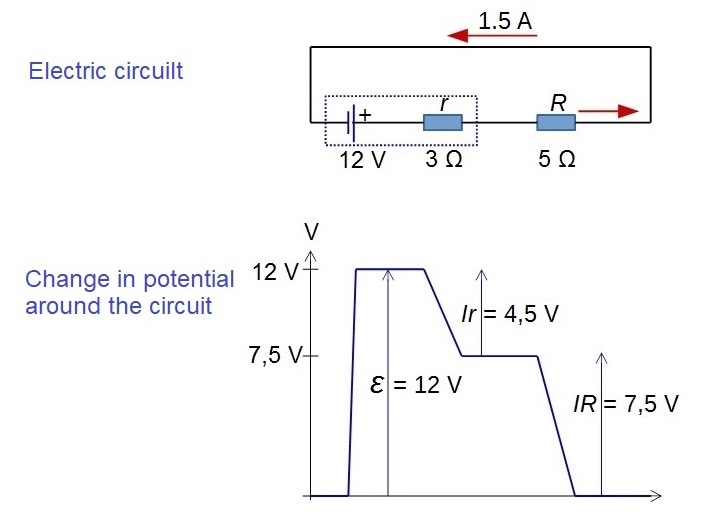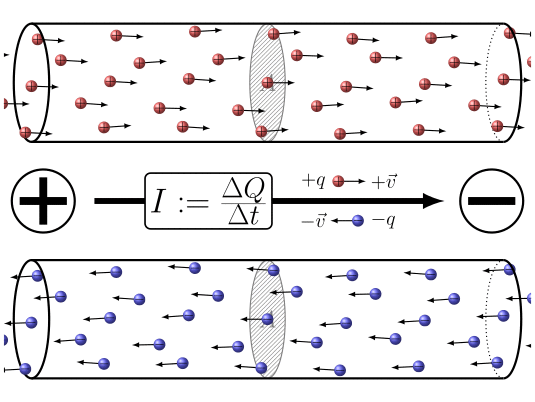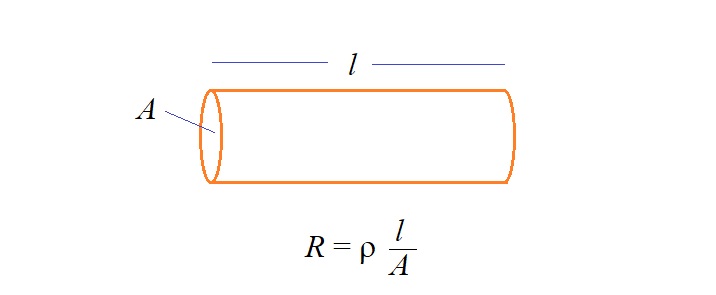
You may already know what an electric circuit is. Connect a battery with two wires to a light bulb and that bulb lights up. You have electric circuit.
In this topic, we need to go into more details and learn how to calculate and measure the voltage and current for different circult arrangements.
So what causes the bulb to light up?
The battery pushes electrons through the wire around the circuit. When these electrons go through the light bulb, the bulb lights up.
There are a few things in this sentence we need to think about when we learn physics. Lets start with the flow of electrons. As explained in an earlier article, there electrons in every atom. These electrons normally just stay in the atom. But in the case of metal, like the wire in a circuit, electrons can actually move through the wire through the atoms.
This motion may normally be random. But when the switch is on, the circuit is closed and the battery actually supply some kind of force that causes the electrons to start moving in one direction through the circuit.
This flow of electrons is called an electric current. It has the effect of lighting up the bulb.
Each electron carries a property called electric charge. We think of the current as the rate of flow of electric charge through the wire of the circuit.
Recall from the previous article that "electric charge" is a number that tells us how much electricity there is, just as "mass" is a measure of the amount of inertia.
A phrase that we would see in this topic is "charge carrier". This is a bit abstract. It is supposed to mean something that carries electric charge. It usually refers to electrons. It can also refer to something called "holes" in semiconductor, which is is not in the syllabus now.
But other examples which can be asked in exam question is conducting solutions. Examples are acidic solutions, alkaline solutions and salty solutions. These can have positive or negative charges, which complicate things a bit.
As an example, for electric current in normal metal wires, there is a formula we need to learn. I am not talking about Ohm's law, which we need to know also. There is a formula that relates the following quantities to electric current :
- number density of free electrons or ions in the conductor (e.g. metal wire or salt solution),
- amount of electric charge in each of these particles,
- and the average speed these particles can drift through the conductor.
- cross-sectional area of the conductor (like the area at the tip if you cut the wire)
In words, the formula says
electric current
= (number of charged particles per unit volume of the conductor)
x (cross sectional area of the conductor)
x (average velocity)
x (electric charge on each particle)
It makes sense - if any of the above quantities are bigger, then the electric current would be bigger.
I have talked about the idea of "electric charge" in an earlier article - on electric fields. The examples are on electric charges resting on a shirt or some object. As the name "static" in electrostatic suggests, those charges are at rest.
In the topic on "current electricity", as the name "current" suggests, it is about electric charges that flow like a water current. Apart from being just decriptive, the word current in this topic on electricity is given a very specific meaning:
- bascially how much electric charge flows per second. This an the next few equations are often needed for basic calculations in this topic.
The next important word in electricity is "voltage". Whereas current is about how much electric charge (like electrons) flows through every second, voltage is about how much work you need to do to push this electric charge through. Ok, maybe not you, but the battery doing the work "pushing".
Voltage may be a bit more abstract to understand. Lets us an example to help us understand. Instead of electric charge like electrons, lets talk about bricks.
Suppose there is a pile of bricks on the ground and I need to lift them up one by one to put on a trolley. Suppose each brick has a mass of 1 kilogram (kg), and suppose that I need to use 10 joules (J) of work to to lift every brick. So I can describe this effort as 10 Joules per kilogram, or 10 J/kg.

Back to our electric circuit. Suppose I connect a battery to a light bulb in a loop with a 1.5 Volts battery. The bulb lights up. It lights up because the battery starts pushing tiny electrons round the circuit. These electrons would feel the most resistance (like friction) when going through the light bulb. The resulting heat makes the light bulb glow brightly.
In instead of kilogram for mass of a brick, the amount of electric charge in electrons is given the unit of coulomb. One coulomb, written as 1 C, of electrons is made up of about 6 billion billion electrons. That sounds like a lot, but we are talking about something much smaller than an atom, so it might really not be that much.
But that has this got to do with voltage. Put simply, A 1.5 volt battery means that it would do 1.5 joules of work when it pushes 1 coulomb of electrons round the circuit once.
Have you noticed the electric meter in or outside your home? There are different types. This is an example.

The number displayed on the meter increases every time you switch on your light, charge your smart phone, watch your television. At the end of each month, your electric power supplier would send you a bill to charge for the amount of electricity you used.
But what is this number that the meter displays?
It displays the amount of electric energy your household has used - maybe from the time the meter was installed. The electric company would check the number each month, minus last month's number, calculate the amount you need to pay, and send you the bill.
If you look at the images above, you may be able to see a number with the letters "kWh" next to it. kWh stands for kilowatt hour.
Most people just pay the bill and do not give much thought to what "kWh" means. if you are a physics student though, this is in the syllabus, so you have to know.
Lets start by taking it apart:
kW stands for kiloWatt, and h stands for hour. kiloWatt means 1000 W of power, h means 1 hour. Once this is clear, a physics student should know how to calculate that
3.6 million joules of energy !
To get a better idea of whether it is really a lot, lets take a look at household usage in Singapore. According to the Ministry of Sustainability and the Environment, the HDB flat average monthly usage is 375.9 kWh in 2020.
Using today's rate of 32.57 cents/kWh (with GST), this costs $122.43.
An important part of the physics of an electric circuit is resistance. When we connect a battery to a light bulb, the battery pushes current through the light bulb to make it light up. In the filament light buld, the battery does work on the to push electrons through the filament, resists the current a lot more than the copper wires connecting it to the battery with a voltage V.
The resistance is like friction, and the current would cause the filament to get so hot that it gives out light. The bigger the resistance R, the smaller the current I. The formula relating these quantities are given by this formula
This formula is called Ohm's law. For example, it lets us calculate the resistance of the light bulb if we know the the voltage V and current I, which can be measured by a voltmeter and an ammeter.
Most people have an idea of what "voltage" is, even if they don't know what voltage really means.
They would have have heard of electric "current", and would know that too much of it is dangerous. And that somehow, when you connect a battery to a light bulb, something flows and the bulb lights up.
But they may not know that the light bulb somehow resists and slow down the electric current flowing through it.
They also may not know that there are some types of materials where this resistance can be adjusted by applying a bit of voltage, nor what this have to do with all the fantastic electronics we have today.
One example is the thermistor. This is a small component whose resistance to electric current decreases if it gets hot. That mean more current can flow through it. This is unusual because normal metals like copper wire tends to resist current more when hot.
What is the use of this? One example is fire alarm. Thermistor can be used to automatically switch on a fire alarm when it gets hot, like where there is a fire
Another example is the semiconductor diode. This allows electric current to flow in one direction but not the reverse direction. This apparently simple device is actually the foundation of our modern electronics and computer technology.
For a normal metal wire, like the common copper wire, its resistance would increase if it get hot. For now, lets assume that it is connected to a battery circuit and has a low current, so that it does not get too warm.
You would find that if you use a longer wire, the current would drop. But if you use a thicker wire the current would increase. It is a bit like a water pipe. A wider water pipe gives less resistance to the water, and a long water pipe would slow down the flow.
The resistance of a wire can be calculated using this formula:
This is usually written using symbols like this

Finally, lets take a look at the battery by itself, not connected to anything else. Suppose that I measure its voltage with a voltmeter and got a reading of 1.5 V.
Then suppose that we connect this to a light bulb in a circuit. The bulb ligts up. But now the voltmeter shows only it may be only 1 V across the battery. Why does the voltage drop so much? What happened to that missing 0.5 V ??
It turns out that the battery itself has resistance. It is called "internal resistance". So some of the voltage has to be used to push the current through the battery itself!
Remember the basic meaning of the word "voltage" - the amount of work needed to being unit electric charge from one point to another.
So the voltage of the battery when it does not have a current flowing is in a sense the actual voltage of the battery. It also has a special name : e.m.f., which stands for electromotive force.
You can learn these concepts and more at Dr Hock's maths and physics tuition.